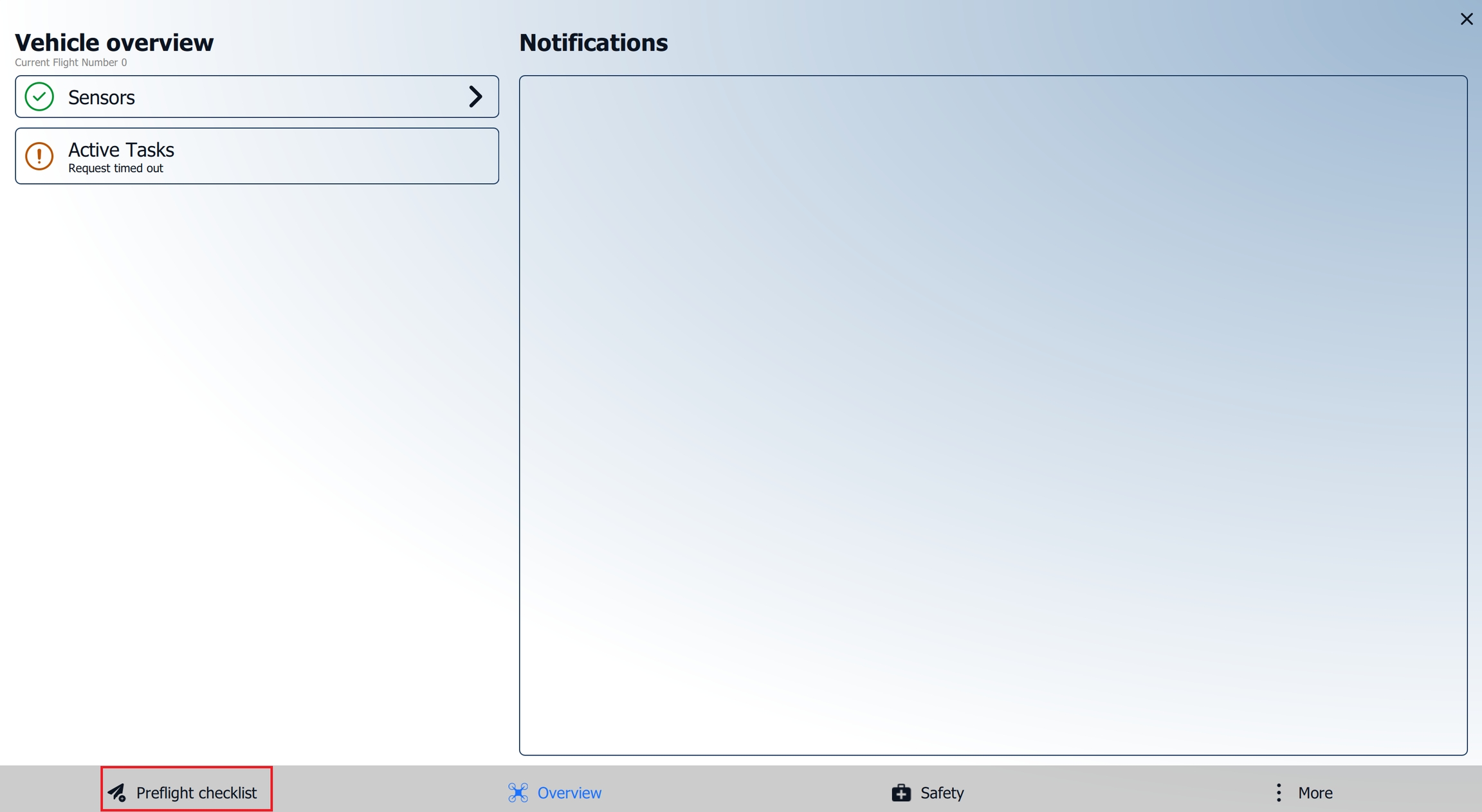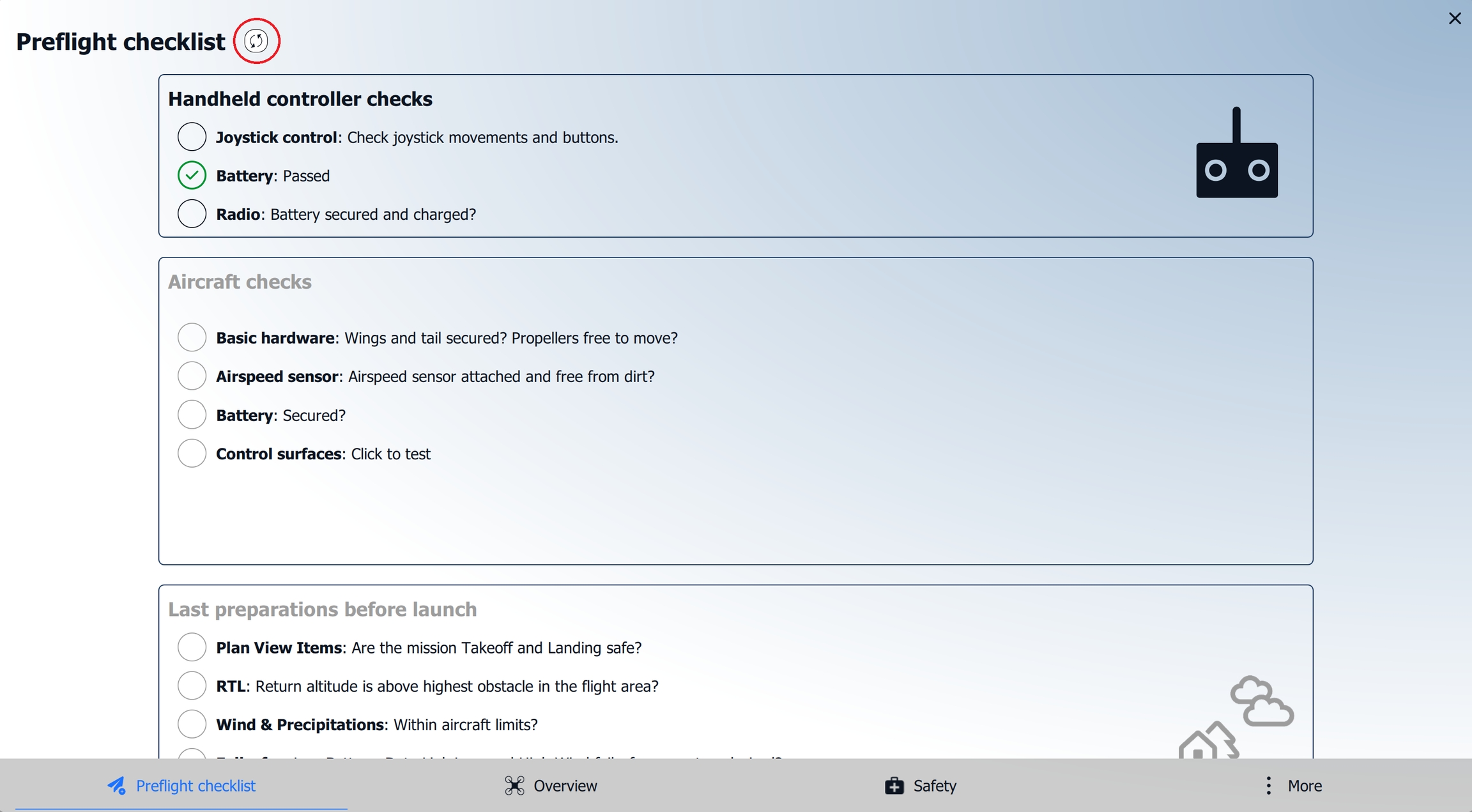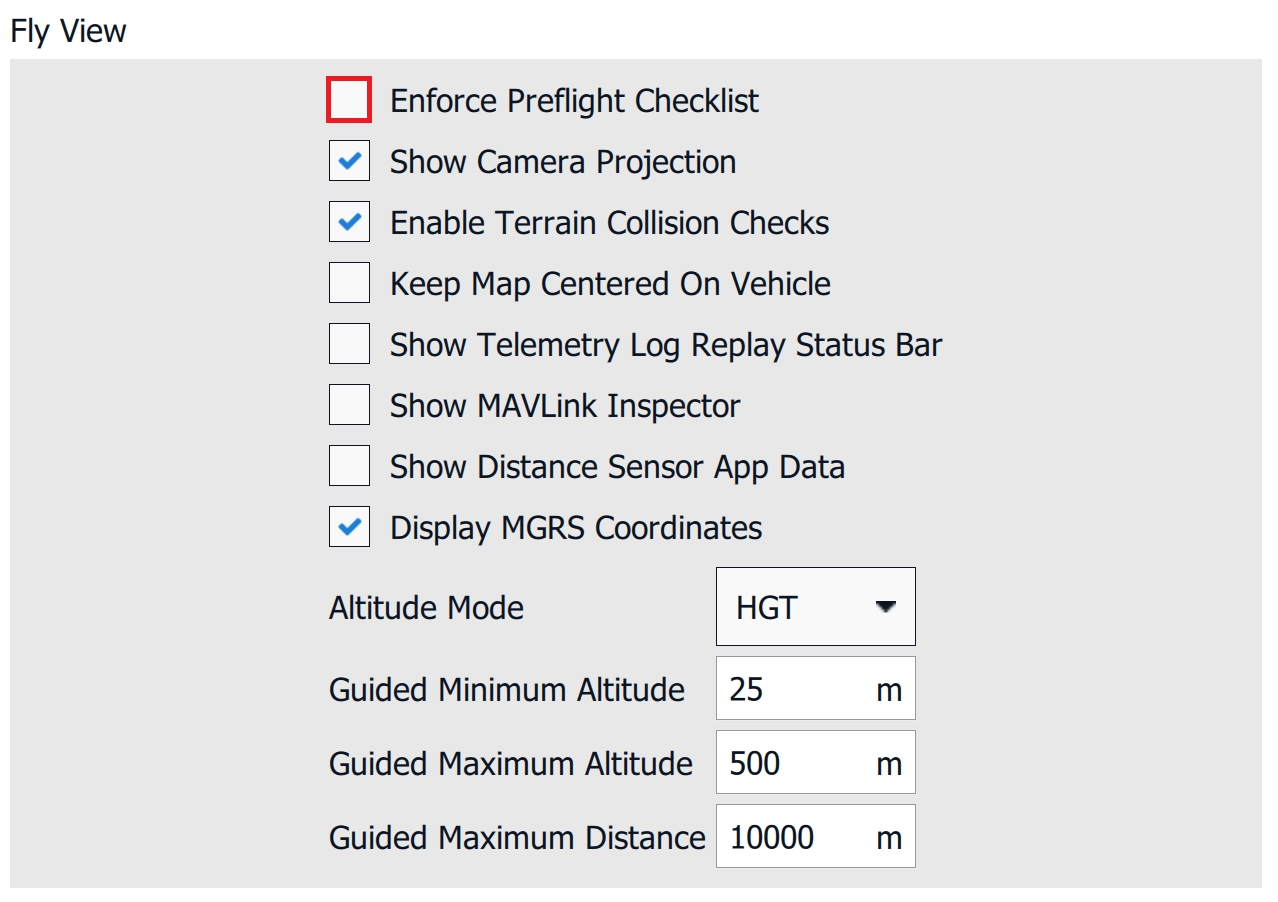Pre-flight Checks
This chapter discusses all items of the pre-flight checklist.
The pre-flight checklist is a comprehensive list of tasks and inspections performed before taking off to ensure that the DeltaQuad Evo is ready for safe and efficient operation. It typically includes verifying equipment functionality, checking battery levels, confirming GPS signals, inspecting hardware for damage, and reviewing flight plans.
The pre-flight checklist is crucial because it helps prevent mechanical failures, ensures that all systems are operational, and minimizes the risk of in-flight issues. By systematically verifying each item, operators can enhance safety, improve flight performance, and reduce the likelihood of accidents or operational disruptions.
Planned Mission
Mission Compliance: Ensure the mission conforms to all local laws, regulations, and airspace restrictions.
Mission Plan: Verify the mission was planned according to the guidelines outlined in the Plan section of this manual.
Terrain Altitude: Verify that altitudes are set appropriately against terrain height for the entire flight path.
Obstacle Clearance: Maintain a vertical separation of at least 25 meters above the highest obstacle at every stage in the fixed-wing portion of the flight.
Path Clearance: Verify the mission path is free of obstructions for at least 200 meters in each horizontal direction.
VTOL Operations: Confirm proper application of VTOL takeoff and landing procedures.
Takeoff: Ensure the takeoff location is free from obstructions up to the transition altitude for 500 meters in the transition direction and 200 meters in every horizontal direction. In case of a failed airspeed sensor, the vehicle will fully engage the pusher motor for 25 seconds and fly in a straight line before aborting the transition due to a failure to achieve the transition airspeed.
Landing Site: Verify the landing site is free of obstacles and structures taller than the transition altitude.
Orbit Land Pattern: Ensure the orbit and landing approach are clear and maintain at least 25 meters above any obstacle.
Wind Direction: Align the vehicle’s takeoff and landing paths against the wind, pointing the vehicle in the direction from which the wind is coming.
Quick Takeoff (if applicable)
Land Approaches: Ensure obstacle-free sectors are selected for the landing approach. The vehicle will automatically perform the back transition to multirotor mode into the wind, or get as close as possible to this direction given the limitations of the selected sectors.
VTOL Operations: Plan takeoff altitude to be 15 meters above obstacles and landing altitude 25 meters above obstacles.
Holding Pattern: Set VTOL takeoff orbit with at least 25 meters of clearance above obstacles. The orbit's altitude is always 80 meters relative to the takeoff location.
Takeoff: Ensure the takeoff location is free from obstructions up to the transition altitude for 500 meters in the transition direction and 200 meters in every horizontal direction. In case of a failed airspeed sensor, the vehicle will fully engage the pusher motor for 25 seconds and fly in a straight line before aborting the transition due to a failure to achieve the transition airspeed. Strong winds can shift the orbit in any direction, altering its shape. For example, due to wind influence, a circular orbit may change in its shape to become more oval.
Wind Direction: Align the vehicle’s takeoff and transition against the wind, pointing the vehicle in the direction from which the wind is coming.
Airframe
Maintenance Cycles: Ensure the vehicle is within preventive maintenance intervals.
Regulatory Compliance: Confirm the airframe complies with all local rules and regulations and is permitted to fly the intended mission.
Parts Inspection: Check for damage, dirt, secure mounting, and fastening:
Fuselage: Undamaged and clean.
Skid Antennas: Undamaged.
Propellers: Correctly mounted, securely fastened, and free of damage and dirt.
VTOL Arms: Properly mounted and fastened.
VTOL Motors: Spinning freely, no play in the bearings.
Pusher Motor Pod: Correctly mounted, securely fastened.
Pusher Motor: Spinning freely, no play in the bearings.
Wings: Mounted securely, undamaged, and clean.
Wing Tip LEDs: Clean and operational (if applicable).
Elevons: Moving freely, undamaged, and clean.
Payloads: Correctly mounted, and payload-dependent checks completed (SD cards/USB sticks installed if required).
Battery Check: Ensure the flight batteries are undamaged, with no dents or swelling, and that all cables and connectors are intact. When flying with two batteries, ensure both are fully charged and have the same charge level.
Pitot Tube: Clear of damage, dirt, and water. After flights in rain, store the DeltaQuad Evo in a dry space for 24 hours to dry the airspeed sensor and tubes.
Landing Gear: Free of damage and dirt. The vehicle should be launched from a solid surface free of mud as the landing gear can collect mud and add weight to the vehicle.
Hatch: Free of damage and dirt.
Cold Weather Considerations (Below 5°C)
Ice, Snow, or Mud: Ensure the landing gear is free from ice, snow, or mud as this can result in the landing gear legs freezing onto the VTOL arms not being able to deploy during landing.
Solid Surface Launch: The vehicle should be launched from a solid surface free of snow or mud.
Pitot Tube Icing: Verify the pitot tube is ice-free.
Battery Temperature: Batteries must be heated above 10°C before takeoff.
Before Closing Hatch
Sunlight Exposure: Avoid exposure to direct sunlight when idle for more than 5 minutes to prevent overheating.
Flight Batteries: Ensure batteries are properly installed, power connectors securely connected, and fully seated. When operating with an auxiliary battery, ensure the locking latch is rotated 90 degrees to secure the battery.
Payloads: Verify payloads are installed and detected. Custom payloads must not exceed 3 kg in total.
APDS Payload: Ensure APDS cargo cannot move excessively during flight. (If applicable, use compartment dividers.)
System Status: The DeltaQuad Evo status OLED reads Ready to fly.
After Closing Hatch
Hatch Security: Ensure the hatch is secured, with the closing mechanism pushed down, locked, and sitting flush with the fuselage.
Vehicle Positioning: Position the vehicle on the designated takeoff/landing zone, facing into the wind.
Before Takeoff
Weather Conditions: Ensure weather conditions are within mission tolerances. Verify that wind speed and gust limits are within safe VTOL and fixed-wing operation parameters.
Communications Check: Confirm communication between UAV and GCS is reliable. If in use, check the VPN connection.
GCS Warnings: Verify no warnings appear on the GCS.
GPS Lock: Ensure stable GPS lock with at least 10 satellites.
Vehicle Status: Confirm “Ready to Fly” status (green label) in AMC. If Position not available, do an in-field compass calibration. (Oscillate the drone around its three axes by approximately ±30 degrees.)
Failsafe Settings: Confirm safety features are set correctly, and failsafe settings are properly configured in case of communication loss or low battery.
As stated in this manual, when an RTL (Return-to-Land) is triggered, the vehicle will return from its current location to the landing pattern in a straight line at its current altitude. If the current altitude is below the Minimum Return Altitude, the vehicle will ascend to the set Minimum Return Altitude during its return. The Minimum Return Altitude must be set higher than any obstacle in the mission area. The RTL failsafe will ignore all exclusionary geofences and the boundary of a complex inclusionary geofence.
Physical Orientation: The vehicle's current physical orientation should match the heading observed on GCS.
Battery Check: Verify in AMC that the flight battery indicator shows a full charge (greater than 95%).
Complete AMC Preflight checklist: Ensure all items are completed, including:
Ground Equipment Charge: Ensure ground equipment has sufficient charge to perform the mission.
Airspeed Sensor: Verify positive airspeed in telemetry. To test provide airflow in front of the pitot tube.
Control Surfaces Check: Perform control surfaces functionality check.
Mission Upload: If applicable confirm the mission plan is uploaded.
Clear Takeoff Area: Check for a clear takeoff area and airspace.
Interactive Preflight checklist in AMC
To access the interactive Preflight checklist in AMC, click on the Vehicle Status Indicator in the screen's upper left corner.

The Vehicle overview window opens. Click on the Preflight checklist tab in the lower-left corner of the window.

Go through each step of the Preflight checklist. The checklist can be reset to start over by clicking on the reset icon on the upper-right side of the screen.

You can enforce the Preflight checklist. Navigate to AMC menu -> Setting -> General -> Fly View.

Before each flight, the pre-flight checklist from the manual needs to be completed. The interactive Preflight checklist in AMC is part of that checklist, as the actuators will be checked, for example. It is NOT sufficient to only go through the interactive Preflight checklist in AMC.
Last updated